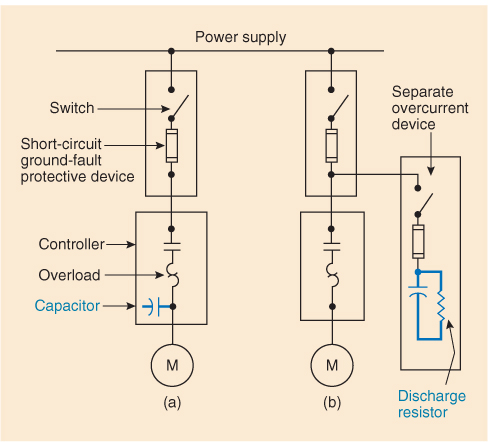I would start by sizing capacitor @ 135%...hope this helps.

your motor's FLC appears to be 50a for your motor even though the nameplate is provided....sometimes you have to use the FLC in certain situations.
Where a capacitor is connected on the load side of the motor overload relays [see
Exhibit 460.1, diagram (a)], the line current will be reduced due to an improved power factor, which must be taken into account when selecting the rating of a motor overload device. A value lower than that specified in
430.32 should be used for proper protection of the motor.
The most effective power factor correction is obtained where the individual capacitors are connected closest to the inductive load. Capacitor manufacturers publish tables in which the required capacitor value is obtained by referring to the speed and the horsepower of the motor. These values improve the motor power factor to approximately 95 percent. To improve a plant power factor, capacitor manufacturers also publish tables to assist in calculating the total kVAr rating of capacitors required to improve the power factor to any desired value.
Unless the exception applies, the overcurrent device must be separate from the overcurrent device protecting any other equipment or conductor. See
Exhibit 460.1, diagrams (a) and (b).
EXHIBIT 460.1 Methods of connecting capacitors in induction motor circuit for power factor correction.
460.8(C) Disconnecting Means.
A disconnecting means shall be provided in each ungrounded conductor for each capacitor bank and shall meet the following requirements:
- (1)
The disconnecting means shall open all ungrounded conductors simultaneously.
- (2)
The disconnecting means shall be permitted to disconnect the capacitor from the line as a regular operating procedure.
- (3)
The rating of the disconnecting means shall not be less than 135 percent of the rated current of the capacitor.
Exception: A separate disconnecting means shall not be required where a capacitor is connected on the load side of a motor controller.
460.9 Rating or Setting of Motor Overload Device.
Where a motor installation includes a capacitor connected on the load side of the motor overload device, the rating or setting of the motor overload device shall be based on the improved power factor of the motor circuit.
The effect of the capacitor shall be disregarded in determining the motor circuit conductor rating in accordance with
430.22.




